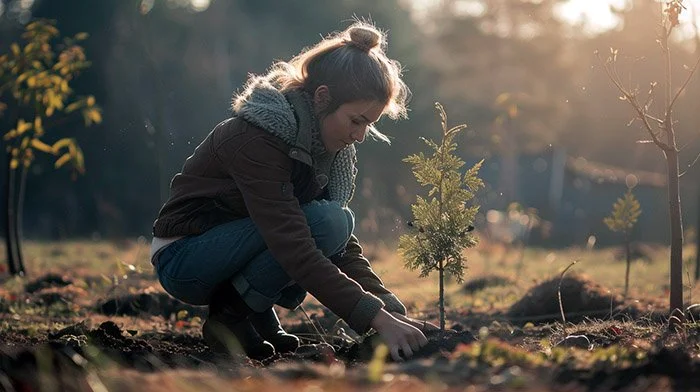Celebrating Arbor Day: History and How to Get Involved
Arbor Day is a special time to honor the trees that give us life. It's more than just planting trees; it's about coming together for a greener tomorrow. Today, as we face environmental challenges, Arbor Day's message is more important than ever.
The celebration of Arbor Day is closely tied to sustainable and controlled environment agriculture (CEA). These modern practices share Arbor Day's goal of nurturing the Earth. They help us grow food in harmony with nature. Let's dive into the roots of Arbor Day and how we can all participate.
What Is Arbor Day?
Arbor Day first took root over a century ago. It started as a simple idea: to set aside a day for planting trees. Now, it's a global movement. Arbor Day shows how trees are crucial to our planet. They clean our air, provide oxygen, and offer homes to wildlife.
Arbor Day history goes back farther than you might guess. The first Arbor Day was celebrated in Nebraska on April 10, 1872. Pioneered by J. Sterling Morton, it led to planting over a million trees in Nebraska alone. Since then, the idea has grown like a mighty oak. Many countries around the world now have their own version of Arbor Day.
Today, Arbor Day is more than history. It's a call to action against climate change. Trees absorb carbon dioxide, making them powerful tools in this fight. They also protect our soil and give us clean water. Arbor Day invites us to plant trees and look after our environment. It's a day to reflect on the role each of us plays in protecting our planet.
The Significance of Arbor Day in the Age of Climate Change
Arbor Day's mission has never been more vital as the world grows warmer. Trees are powerful allies against climate change. They absorb CO2, one of the main greenhouse gasses. A single mature tree can consume roughly 48 pounds of CO2 a year. This process helps cool the planet.
Research on the subject comes from organizations like the Arbor Day Foundation and studies reported by NASA. The data underlines trees' role in climate mitigation. They show that strategic tree planting can significantly reduce carbon in the atmosphere. For instance, urban trees can lower city temperatures, reducing the need for air conditioning. Trees also prevent soil erosion, protect water sources, and support biodiversity.
Sustainable agriculture practices share Arbor Day's vision. These include methods like controlled environment agriculture (CEA) and vertical farming. They aim for harmony with nature. CEA uses less water and less land, helping to preserve these resources. Vertical farming takes this further, growing plants in stacked layers to save space and water. Both methods reduce the need for extensive land use. They complement tree-planting efforts by conserving natural habitats. They can also free up agricultural land for reforestation.
Celebrating Arbor Day: Beyond Traditional Tree Planting
Arbor Day is evolving. Today, it embraces new ways to grow plants, including vertical farming and hydroponics. These methods don't just save space and water. They open up new possibilities for greening urban areas.
Vertical farming allows us to cultivate plants in city buildings, rooftops, and balconies. It's an efficient way to produce food locally and add greenery to urban environments. Hydroponics, growing plants without soil, is another innovative approach. It uses nutrient-rich water, saving up to 90% more water than traditional farming.
Community projects can harness these technologies for urban greening. These initiatives can involve small projects like creating a vertical garden in a school classroom. Or they could involve more extensive programs like hydroponic community centers. No matter their scale, they can bring nature into dense cities. They provide fresh air, reduce urban heat, and connect residents to nature. Perhaps best of all, they inspire communities to contribute to a healthier planet year-round.
Arbor Day and Earth Day
Arbor Day and Earth Day are two sides of the same leaf. Both celebrate our planet, focusing on conservation and the environment. Earth Day is observed on April 22nd each year. This holiday advocates for a wide range of environmental actions and awareness. Earth Day initiatives include everything from recycling to reducing carbon footprints. It builds on Arbor Day's foundations to include a wider array of sustainable activities.
These holidays remind us of the impact we have on our planet and the steps we can take to mitigate it. While the history of Earth Day is not as long as Arbor Day, these twin holidays go hand in hand. Together, they reinforce the importance of sustainable living and environmental stewardship.
Getting Involved: Arbor Day and Sustainable Agriculture
Celebrating Arbor Day can go hand in hand with embracing sustainable agriculture. Opportunities abound whether you're a seasoned gardener or new to the green scene. Starting small-scale hydroponic or vertical farming projects can be a great way to mark the occasion. Planting trees and beneficial plants contributes to your immediate environment. It also supports global sustainability efforts.
Consider setting up a hydroponic system for growing fruit trees or a vertical garden with herbs and other plants. These projects require minimal space and can be a fun, educational tool for families, schools, and communities.
The Arbor Day Foundation offers resources and guides for those looking to dive deeper. They can help you get started with tree planting and sustainable gardening practices. They also have a list of events by state or territory.
Additionally, the National Wildlife Federation offers a Trees for Wildlife program. It offers an excellent opportunity for communities to receive trees for planting. This initiative makes it easier to get involved and make a difference.
Arbor Day's tree-planting mission integrates with sustainable agriculture techniques like hydroponics and vertical farming. By doing so, individuals and communities can contribute to a greener future. These efforts beautify our surroundings. They also tackle environmental challenges, creating a healthier planet for future generations.
Bringing Arbor Day into the Classroom
Arbor Day offers a unique opportunity to bring nature's classroom to students. It's a chance to delve into the importance of trees and sustainable agriculture. Through interactive lessons, students can grasp the critical role of trees in maintaining a healthy planet. They can also learn how modern farming techniques can benefit the planet rather than harming it.
Introducing Students to Arbor Day and Sustainable Agriculture
Begin with engaging presentations that walk students through Arbor Day's roots and significance. Highlight the essential functions trees serve in our ecosystem. These include air purification, habitat provision, and climate regulation.
Then, bridge these discussions to sustainable agriculture. Explain controlled environment agriculture (CEA), vertical farming, and hydroponics. Describe how these techniques are modern methods that conserve water and land. Explore how they offer a greener alternative to traditional agriculture. This educates and inspires students about the possibilities of sustainable living.
Interactive Learning Activities
Integrating Arbor Day into the educational experience can be a rewarding challenge. It can transform how students perceive their environment and their role in sustainability. Beyond tree planting, here are more interactive learning activities that schools can use to celebrate Arbor Day and foster a deeper understanding of nature and conservation:
Tree Planting Project: A hands-on tree planting activity is a perfect way to celebrate Arbor Day. You can do this on school grounds or in collaboration with local parks. Either way, this project can instill a sense of responsibility and connection to the environment. It's an educational experience that teaches the ecological benefits of trees firsthand. Students will learn not just why we plant trees but how each tree contributes to a healthier earth.
School Garden Creation: Develop a school garden that includes both native plants and trees. This activity teaches students about local ecosystems. It also emphasizes the importance of native species in providing habitats for wildlife. It's a hands-on approach to learning about botany, ecology, and the value of biodiversity.
Eco-Art Projects: Invite students to create art using natural materials found around the school or in their own backyards. This could include leaf rubbings, branch weaving, or creating murals with seeds and leaves. Such projects encourage children to observe the beauty and variety of plant life. They help foster a deeper appreciation for the natural world.
Recycled Paper Making with Seeds: Teach students how to make recycled paper embedded with tree or flower seeds that can be planted. This activity highlights the importance of recycling and shows the lifecycle of paper products. It can emphasize sustainability and the potential for waste materials to contribute to new growth.
Partnering with Eden Green for Your School District
Imagine the impact of fresh, hydroponic produce available right in your school's cafeteria. Eden Green is dedicated to making this a reality. Your school can access nutritious, sustainable fruits and vegetables all year by partnering with us.
This collaboration is more than just about providing healthy food options. It's an educational partnership. Together, we can introduce students to sustainable agriculture practices. We can enrich their learning and contribute to a healthier planet.











